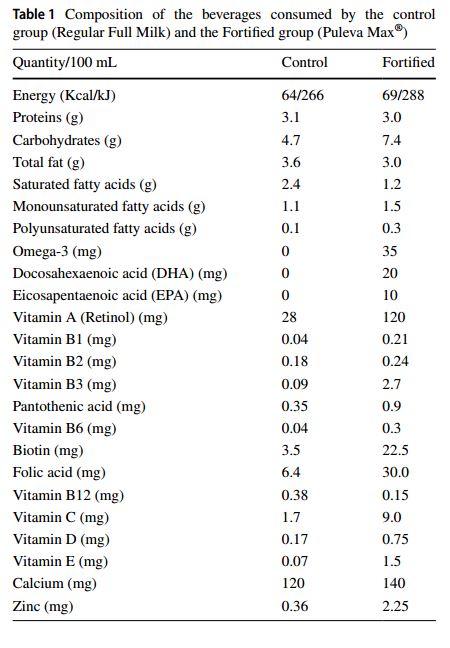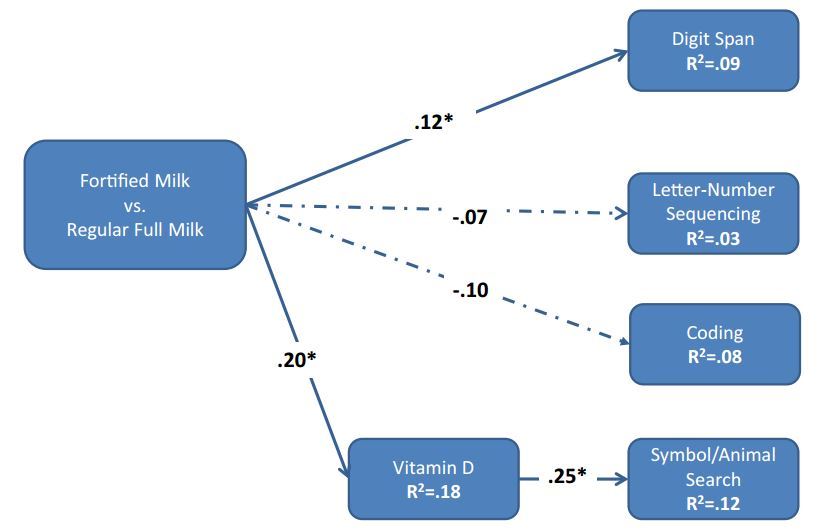Adding Vitamin D, Omega-3, etc to children’s milk improved memory (yet again) – RCT
Еffects of fortified milk on cognitive abilities in school-aged children: results from a randomized-controlled trial.
Eur J Nutr. 2018 Jun 7. doi: 10.1007/s00394-018-1734-x. [Epub ahead of print]
Petrova D1,2, Bernabeu Litrán MA3, García-Mármol E4, Rodríguez-Rodríguez M3, Cueto-Martín B4, López-Huertas E5, Catena A6, Fonollá J7.
 Composition
Composition
 * Note: Puleva Max is a commerical supplement which to add to milk in Spain
* VitamiDWiki is unaware of a similar milk augmentation product for the US
* However, anyone can buy and add water-soluable vitamin D [Amazon Example](https://www.amazon.com/Vitamin-D3-Cholecalciferol-000IU-100/dp/B004HLD1K4/ref=sr_1_2_sspa?s=hpc&ie;=UTF8&qid;=1528570620&sr;=1-2-spons&keywords;=bio-tech+d3-50&psc;=1)
and Omega-3 emulsions [Amazon example](https://www.amazon.com/Liposomal-DHA-Vegan-Non-Allergen/dp/B00I0GWFR2/ref=sr_1_6_a_it?ie=UTF8&qid;=1528570141&sr;=8-6&keywords;=omega-3+emulsion+water) to their child's milk or drink
* see Vitamin D home fortification- don't wait 100 years for your govt
* Something seems wrong with the Vitamin D units: 0.75 micrograms = 30 IU, a very small amount
* which is 1/10X of milk fortified in the US
Fig. 2 Multiple regression results on % change scores.
* Note: Puleva Max is a commerical supplement which to add to milk in Spain
* VitamiDWiki is unaware of a similar milk augmentation product for the US
* However, anyone can buy and add water-soluable vitamin D [Amazon Example](https://www.amazon.com/Vitamin-D3-Cholecalciferol-000IU-100/dp/B004HLD1K4/ref=sr_1_2_sspa?s=hpc&ie;=UTF8&qid;=1528570620&sr;=1-2-spons&keywords;=bio-tech+d3-50&psc;=1)
and Omega-3 emulsions [Amazon example](https://www.amazon.com/Liposomal-DHA-Vegan-Non-Allergen/dp/B00I0GWFR2/ref=sr_1_6_a_it?ie=UTF8&qid;=1528570141&sr;=8-6&keywords;=omega-3+emulsion+water) to their child's milk or drink
* see Vitamin D home fortification- don't wait 100 years for your govt
* Something seems wrong with the Vitamin D units: 0.75 micrograms = 30 IU, a very small amount
* which is 1/10X of milk fortified in the US
Fig. 2 Multiple regression results on % change scores.
 The models controlled for age, gender, and changes in calcium, iron, ferritin, DHA, and BMI levels.
Coefficients are unstandardized B. R2=percentage of variance explained (average across imputations).
Dashed lines indicate non-significant effects
---
1. See also VitaminDWiki
* Infants getting 1 g of Omega-3 for 12 weeks got better brains – RCT March 2017
* Omega-3 helps childhood cognition – meta-analysis April 2016
The models controlled for age, gender, and changes in calcium, iron, ferritin, DHA, and BMI levels.
Coefficients are unstandardized B. R2=percentage of variance explained (average across imputations).
Dashed lines indicate non-significant effects
---
1. See also VitaminDWiki
* Infants getting 1 g of Omega-3 for 12 weeks got better brains – RCT March 2017
* Omega-3 helps childhood cognition – meta-analysis April 2016
📄 Download the PDF from VitaminDWiki
BACKGROUND:
Micronutrients such as vitamins and minerals and long-chain polyunsaturated omega-3 fatty acids (PUFAs) are essential for children's brain development and cognitive functions. The current study investigated whether milk fortified with micronutrients and PUFA can result in improved cognitive function in mainstream school children.
METHODS:
One-hundred-and-nineteen children (age 8-14, 58 boys) were randomly allocated to a fortified milk group or a regular full milk control group. Participants consumed 0.6L/day of the milk for 5 months. We recorded relevant biochemical, anthropometric, and cognitive measures (working memory and processing speed) at the start of the study and at follow-up after 5 months.
RESULTS:
The fortified milk significantly increased docosahexaenoic acid (DHA) (change from baseline of 28% [95% CI 17-39%] vs. -6% [95% CI - 13 to 0%] in the control group) and serum 25OH-vitamin D concentrations (41% [95% CI 30-52%] vs. 21% [95% CI 11-30%] in the control group).
The fortified milk improved working memory on one of two tests (32% [95% CI 17-47%] vs. 13% [95% CI 6-19%] in the control group).
The fortified milk also indirectly increased processing speed on one of two tests; this effect was small and completely mediated by increases in 25OH-vitamin D concentrations.
CONCLUSIONS:These results suggest that fortifying milk with micronutrients and PUFA could be an effective and practical way to aid children's cognitive development.
